Makhana Kheer, also known as Phool Makhane ki Kheer, is a luxurious Indian dessert made by slow-cooking puffed lotus seeds (fox nuts) in milk. Infused with aromatic cardamom, strands of saffron, and just the right amount of sweetness, this creamy delight is both comforting and nourishing. This rich and creamy kheer is not only delicious but also packed with nutrition, making it a wholesome treat for both festive occasions and everyday indulgence.
Traditionally, makhana kheer holds a special place during Hindu fasting rituals like Navratri, Ekadashi, Shivratri, and other vrat (upvas) occasions. Regarded as a satvik (pure and spiritually clean) dish, it aligns perfectly with the dietary restrictions followed during these sacred periods. Since it is completely grain-free and free from onions, garlic, and other non-satvik ingredients, it becomes an ideal and nourishing choice for those observing fasts. Its light yet indulgent nature makes it both spiritually appropriate and satisfying to the palate.
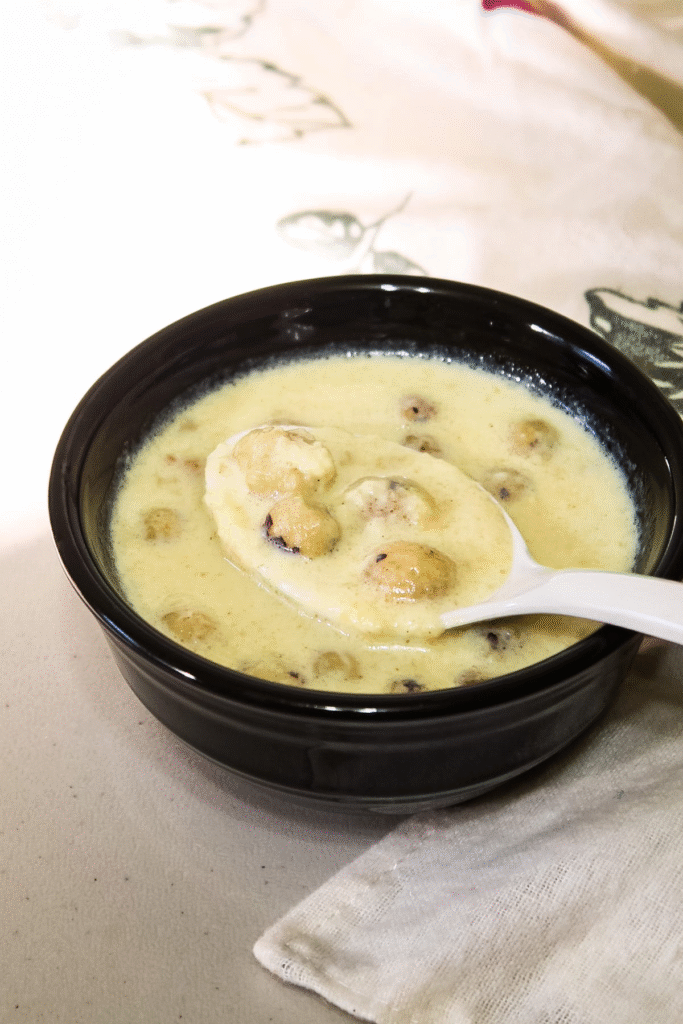
What makes this sweet dish truly special is the way the fox nuts soak up the flavors of saffron-infused milk and turn soft and spongy, offering a delightful texture in every bite. A handful of crushed makhanas are also added for some body and thickness, while ghee-roasted dry fruits bring a lovely crunch and richness to the final dish.
Unlike regular rice-based kheer, makhana kheer is lighter and easier to digest, yet equally satisfying. It’s naturally gluten-free and can be easily customized to suit vegan or low-sugar diets too.
Whether you’re celebrating a festival, observing a fast, or simply craving something indulgent and comforting, this makhana kheer is a perfect dessert choice. Enjoy it warm for a cozy treat or chilled for a refreshing delight—either way, it’s irresistibly delicious.
❤️ What Is Makhana?
Makhana, also known as phool makhana, fox nuts, or puffed lotus seeds, is a nutritious and light ingredient prized for its health benefits and easy digestibility. Widely recognized in Ayurveda for its therapeutic properties, it’s considered a sattvic food, making it ideal for fasting (vrat or upvas) days.
These puffed seeds are incredibly versatile—used in both sweet treats and savory dishes. When lightly roasted with a sprinkle of spices, makhana transforms into a crunchy, guilt-free snack, similar to vagharela mamra. In many North Indian households, makhana becomes a staple during fasting periods, offering a nourishing alternative to carb-heavy dishes like potatoes and sabudana.
Since fasting meals often lean heavily on starchy ingredients, it’s important to balance nutrition by incorporating makhana, along with dried fruits, nuts, and fresh fruits, to maintain energy and support overall well-being.
🧾 Ingredients For Makhana Kheer
Take a look at the ingredients—just 7 simple staples and 25 minutes are all it takes to whip up this luscious and creamy Makhana Kheer. This picture captures everything you need to create this quick, festive delight!
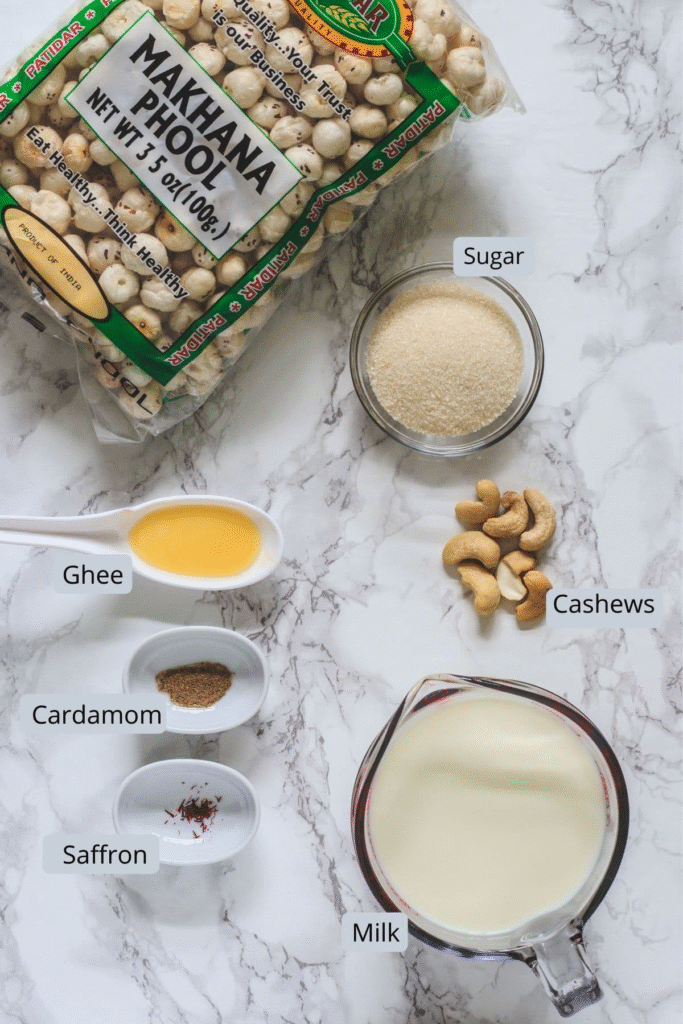
- Makhana (Fox Nuts): Makhana, also known as fox nuts or puffed lotus seeds, is the key ingredient in this recipe. It is widely available in Indian grocery stores across the USA, typically found in the snacks or dry goods section. These puffed seeds are incredibly light, crunchy, and neutral in flavor, making them perfect for soaking up the rich taste of milk and spices. Apart from being a fasting staple, makhana is also prized for its numerous health benefits, including being a good source of protein, fiber, and antioxidants.
- Sugar: The quantity of sugar used in this kheer is just enough to lend a pleasant sweetness that balances the richness of the milk and the delicate flavor of makhana. If you have a particularly sweet tooth or are making it for guests who prefer richer desserts, feel free to adjust the sugar level according to your preference. You can also explore healthier alternatives like coconut sugar or jaggery if you’re looking for a slightly earthy or rustic taste.
- Milk: Whole milk, or full-fat milk, is highly recommended for this recipe as it provides the desired creaminess and luxurious texture that defines a traditional Indian kheer. Using low-fat or skim milk will significantly reduce the richness and may make the kheer thinner and less satisfying. For those looking for a dairy-free version, unsweetened almond milk or coconut milk can be used, but expect a change in flavor and consistency.
- Saffron and Cardamom: These two ingredients are the heart of Indian desserts, and in makhana kheer, they play a vital role in enhancing its aroma and taste. Saffron strands add a subtle golden hue and a mild floral flavor, while freshly ground green cardamom brings a warm, inviting fragrance that lingers with each bite. For best results, soak the saffron strands in warm milk before adding them to the kheer, allowing the color and flavor to bloom beautifully.
- Cashews (Or Nuts of Choice): Cashews not only add a slight crunch but also provide richness to the kheer. However, you can easily substitute them with other nuts such as sliced almonds, slivered pistachios, or even a mix of your favorites. If you enjoy some extra sweetness and texture, throw in a handful of golden raisins or chopped dates. Lightly roasting the nuts in ghee before adding them elevates the flavor and adds a delightful nuttiness to the dish.
👩🍳 How To Make Makhana Kheer? (Pics)
1) Begin by pouring full-fat milk into a deep, heavy-bottomed saucepan and place it over medium heat. Let the milk slowly come to a gentle simmer. Stir it occasionally with a spatula or ladle to avoid scorching at the base. Allow the milk to simmer for about 7–8 minutes until it slightly thickens and takes on a creamy texture.
2) While the milk is simmering, place a separate pan on another burner and heat the ghee over medium flame. Once the ghee is hot, add the cashew nuts and roast them until they turn golden and aromatic. Remove them with a slotted spoon and transfer to a bowl. In the same pan, toss in the raisins and sauté until they puff up beautifully. Let the extra ghee drip off, then transfer them to the same bowl with the golden roasted cashews. Set aside for garnishing.
3) Continue roasting until they become crunchy and take on a light golden hue. Let the ghee infuse its flavor while the makhana gets perfectly toasted. Stir continuously to ensure they get evenly golden and crispy without burning.
4) Transfer the roasted makhana to a plate and let them sit for a few minutes, allowing them to cool slightly until they’re comfortably warm when touched. Meanwhile, keep an eye on the simmering milk to prevent it from boiling over. Once the makhana have cooled, take a small portion and gently crush them with your fingers or between your palms into a coarse powder. This will dissolve into the kheer as it simmers, naturally thickening it and adding a rich body to the dessert.
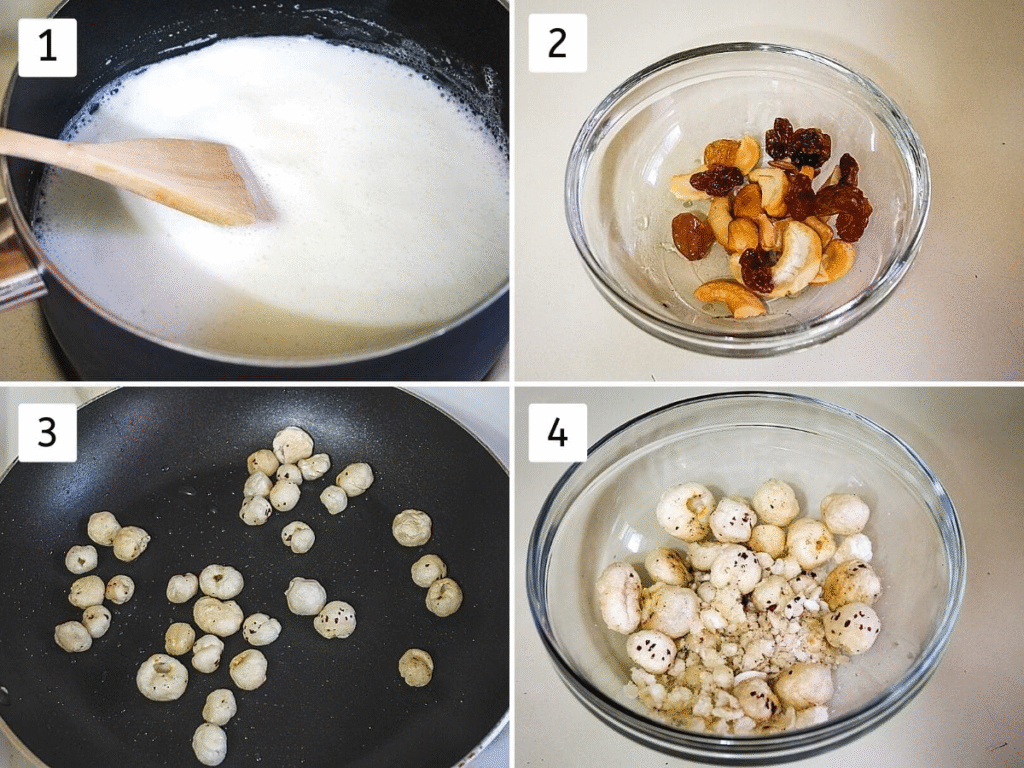
5) By now, the milk should have reduced and thickened a bit. Stir in a few saffron strands, which will slowly infuse a beautiful aroma and golden hue.
6) Now, add both the whole roasted makhana and the coarsely crushed portion into the simmering milk. Mix well.
7) Let the mixture cook together for another 4–5 minutes on low heat, stirring gently. The makhana will absorb the flavors and become soft while also helping the kheer to thicken further.
8) Mix in the sugar and let the kheer bubble softly for 2 to 3 minutes, giving it time to melt fully and infuse the rich, milky base with sweetness.
9) Add the cardamom powder and give it a gentle stir, allowing its warm, floral aroma to blend seamlessly into the dish. Once fully infused, turn off the heat.
10) Finally, top the makhana kheer with the golden-fried cashews and plump raisins for a rich and festive touch.
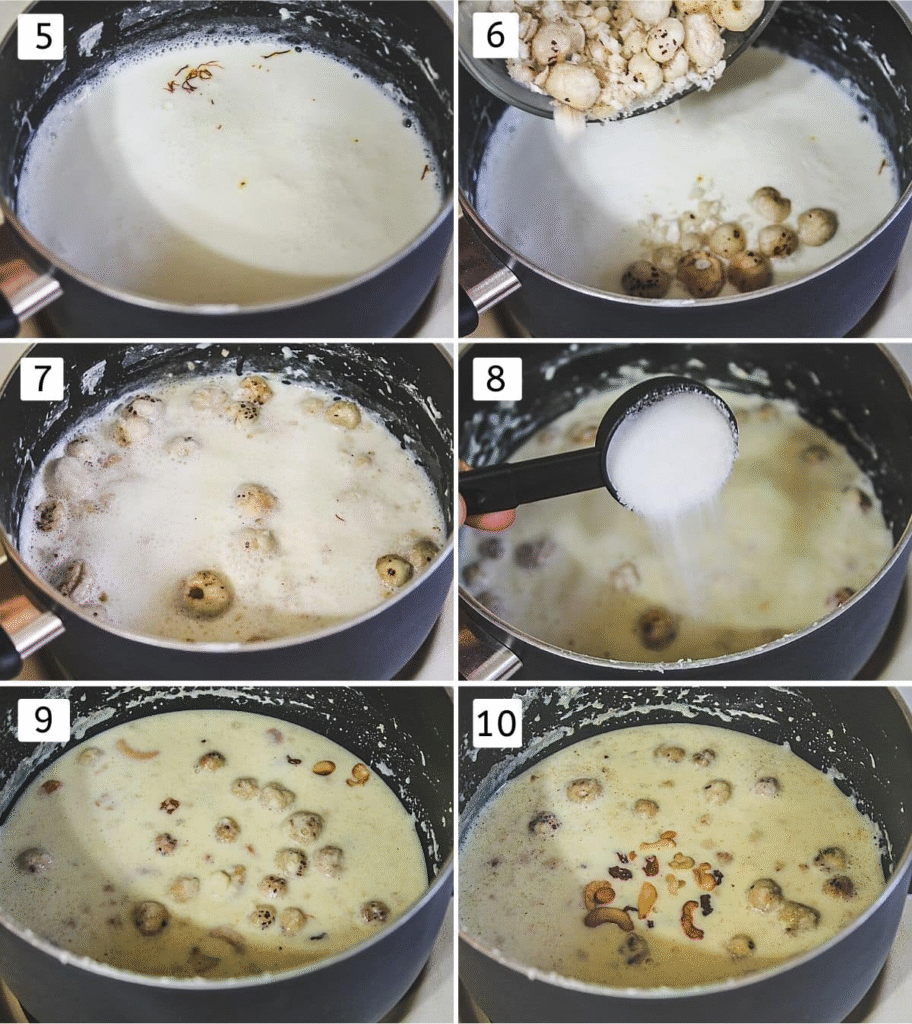
🍽 Serving Ideas For Makhane Ki Kheer
- You can relish makhane ki kheer either warm or cold, depending on your personal preference and the season. For a chilled version, let it cool naturally to room temperature before refrigerating it until nicely cold. Then refrigerate it for a few hours until nicely cold before serving.
- Traditionally enjoyed during fasting days like Navratri or Ekadashi, this kheer often makes a delightful sweet treat after a vrat meal. However, its appeal isn’t limited to festive fasts—you can savor this creamy, comforting dessert any time of the year, whether for celebrations or simple indulgence.
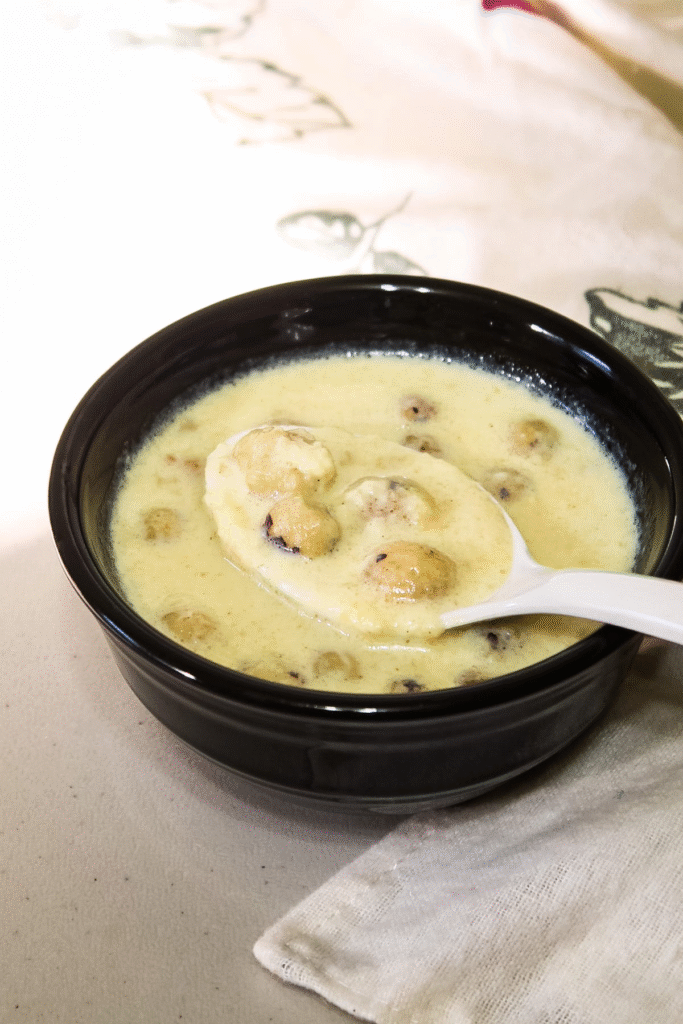
Notes
- If you enjoy your desserts on the sweeter side, feel free to increase the amount of sugar added to the kheer. I personally prefer my makhana kheer to have a mild sweetness that complements the rich, creamy texture without being overpowering. However, sweetness is entirely a matter of personal taste—so adjust according to what you and your family like.
- When it comes to the choice of milk, always opt for full-fat whole milk. It adds a luxurious creaminess and depth to the kheer that low-fat or skim milk simply can’t offer. The high-fat content helps develop a thick and luscious consistency as the milk simmers, enhancing the overall richness of the dish. Using whole milk truly makes a noticeable difference in both texture and flavor, giving your kheer an authentic, indulgent touch.
